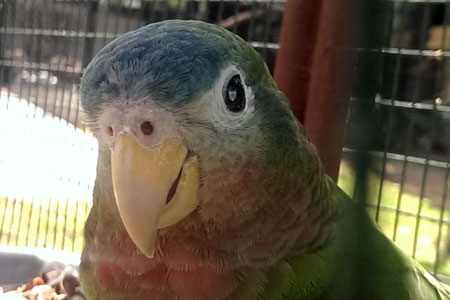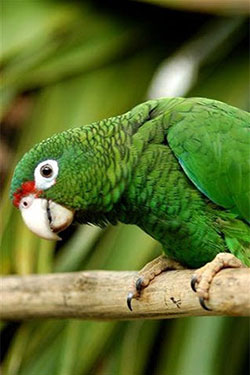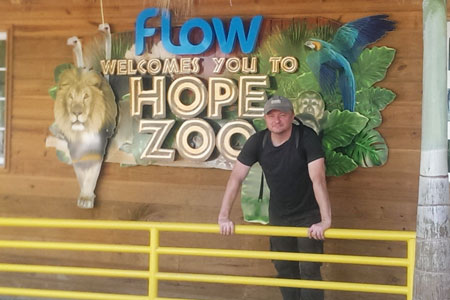- YouTube
- TikTok
OU researchers use genetics to help threatened Amazon parrots
In a paper published in the journal Genes, the researchers mapped mitochondrial genomes of the parrots, providing data that can be used to help save them from extinction.

Yellow-billed Jamaican Parrot at Hope Zoo in Kingston, Jamaica. |
As part of a wide-ranging conservation effort, a group of Oakland University researchers has been mapping the DNA of Amazon parrot species from the Caribbean.
The six species are native to the Yucatan Peninsula, in Central America, and the four Greater Antillean islands of Jamaica, Cuba, Hispaniola and Puerto Rico. The island species are all under threat, particularly the Puerto Rican Parrot, which has been classified as “critically endangered” and placed on the Red List of the International Union for Conservation of Nature.
In a paper published in the journal Genes, the researchers mapped mitochondrial genomes of the parrots, providing data that can be used to help save them from extinction. The study featured 18 co-authors from around the world, including four from OU. Graduate students Stephanie O. Castro-Marquez and Walter W. Wolfsberger worked with Special Lecturer Audrey J. Majeske and Assistant Professor Taras K. Oleksyk in OU’s Department of Biological Sciences.
“Mapping the genomes of these parrots allowed us to reconstruct the timing and order in which each species formed,” said Oleksyk. “We were also able to sequence enough individuals to show how much genetic diversity remains within each species.”
Genetic diversity is crucial to species' ability to adapt and survive in the face of changing conditions, Oleksyk explained. Lack of genetic diversity can leave species vulnerable to threats, especially disease.
“We found that the Puerto Rican Parrot is the most inbred, genetically homogenous species there is,” Oleksyk said. “That’s a big reason why they have required intervention, so they don’t lose more genetic diversity.”
Puerto Rican Parrot |
Known for being the last remaining native parrot in U.S. territory, the Puerto Rican Parrot has inhabited its namesake island for nearly 700,000 years. Its population has been decimated by deforestation and illegal trade. In 1975, only 13 individuals were left. A government-sponsored conservation program helped the population rise to around 600 in the 2000s, but it dropped by more than half after Hurricane Maria struck in 2017.
At the time, Oleksyk was a professor at the University of Puerto Rico–Mayaguez and was already working on sequencing Puerto Rican Parrot genomes to support conservation efforts. Getting the project off the ground took some creative thinking. When funding proved difficult to obtain, Oleksyk and his students organized art shows, fashion shows and a GoFundMe campaign to raise the $10,000 needed for genome sequencing. This grassroots effort, involving researchers, artists, fashion designers and other community members, was hailed as a shining example of citizen science. It was recently featured in an article in the journal Science, Technology, & Human Values.
“People donated time, energy and money toward the goal of saving a beloved species,” said Oleksyk. “Mapping genomes of endangered species will help conservationists conduct breeding programs that avoid inbreeding and preserve genetic diversity.”
By sequencing genomes of Caribbean Amazons, researchers were able to determine the time frame and the context in which each species formed. According to the findings, an ancestral population originally came from Central America to Jamaica via a land bridge that existed when sea levels were low, during an ice age some 3.5 million years ago. This population evolved into the Black-billed Jamaican Parrot.
“The sea levels were a lot lower back then, because a lot more water was trapped in the ice,” Oleksyk explained. “When the ice melted, the waters rose and the islands became more isolated from each other. The geographical distance shaped the evolution of each species as populations moved from one island to another.”
Professor Taras Oleksyk at Hope Zoo. |
From Jamaica, a group of parrots flew to Cuba about 1.39 million years ago and became the Cuban Parrot. Then, a group of Cuban parrots migrated to Hispaniola roughly 770,000 years ago and evolved into the Hispaniolan Parrot. Finally, a group of Hispaniolan Parrots flew to Puerto Rico around 690,000 years ago and became the Puerto Rican Parrot. The evidence also indicates that a group of Cuban Parrots flew back to Jamaica and became the Yellow-billed Jamaican Parrot. To estimate the time of speciation for each parrot, researchers tallied the number of genetic differences (i.e. mutations) between them.
“Counting the differences allowed us to estimate the timing, because mutations accumulate at a constant rate,” Oleksyk explained.
The Hispaniolan Parrot and Puerto Rican Parrot are the most genetically similar of the Caribbean Amazons, with roughly 1,000 differences out of 17,000 DNA base pairs, the researchers determined.
“That’s roughly the same percentage difference between humans and chimpanzees,” Oleksyk noted. “But our research shows that these parrots have been on these islands for a long time – a lot longer than humans. They are resilient and if they have the environment they need, there’s hope for their survival. That’s why it’s important to support them, because they can be helped.”
Oleksyk added that the parrots’ genome maps will enable researchers to identify genes that vary between species. They can investigate the function of these genes to learn more about how each species evolved.
“Charles Darwin called the process of speciation the mystery of mysteries,” said Oleksyk. “This is the mystery we are trying to solve in relation to the Amazon Parrots – the question of how they came to be – and use that knowledge to help them live on.”


 April 29, 2021
April 29, 2021

